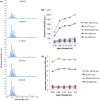The effect of tuning cold plasma composition on glioblastoma cell viability
- PMID: 24878760
- PMCID: PMC4039517
- DOI: 10.1371/journal.pone.0098652
The effect of tuning cold plasma composition on glioblastoma cell viability
Abstract
Previous research in cold atmospheric plasma (CAP) and cancer cell interaction has repeatedly proven that the cold plasma induced cell death. It is postulated that the reactive oxygen species (ROS) and reactive nitrogen species (RNS) play a major role in the CAP cancer therapy. In this paper, we seek to determine a mechanism of CAP therapy on glioblastoma cells (U87) through an understanding of the composition of the plasma, including treatment time, voltage, flow-rate and plasma-gas composition. In order to determine the threshold of plasma treatment on U87, normal human astrocytes (E6/E7) were used as the comparison cell line. Our data showed that the 30 sec plasma treatment caused 3-fold cell death in the U87 cells compared to the E6/E7 cells. All the other compositions of cold plasma were performed based on this result: plasma treatment time was maintained at 30 s per well while other plasma characteristics such as voltage, flow rate of source gas, and composition of source gas were changed one at a time to vary the intensity of the reactive species composition in the plasma jet, which may finally have various effect on cells reflected by cell viability. We defined a term "plasma dosage" to summarize the relationship of all the characteristics and cell viability.
Conflict of interest statement
Figures











References
-
- Keidar M, Isak Beilis (2013) Plasma Engineering: Application in Aerospace, Nanotechnology and Bionanotechnology. 1st ed. Elsevier BV.
-
- Yousfi M, Merbahi N, Pathak A, Eichwald O (2014) Low-temperature plasmas at atmospheric pressure: toward new pharmaceutical treatments in medicine. Fundam Clin Pharmacol 28: 123–135. - PubMed
-
- Shashurin A, Keidar M, Bronnikov S, Jurjus RA, Stepp MA (2008) Living tissue under treatment of cold plasma atmospheric jet. Appl Phys Lett 93: 181501.
-
- Nehra V, Kumar A, Dwivedi H (2008) Atmospheric non-thermal plasma sources. Int J Eng 2: 53–68.
Publication types
MeSH terms
Substances
LinkOut - more resources
Full Text Sources
Other Literature Sources
Miscellaneous

